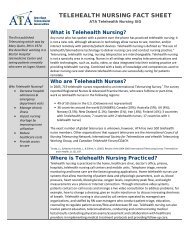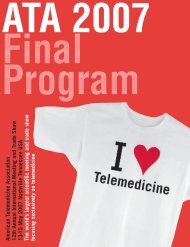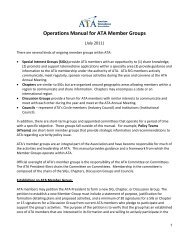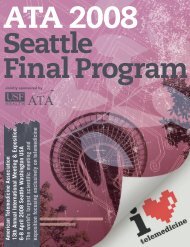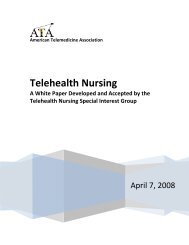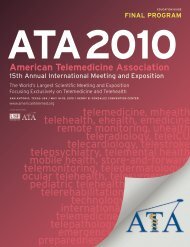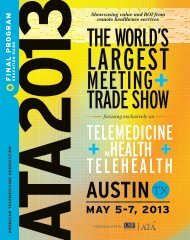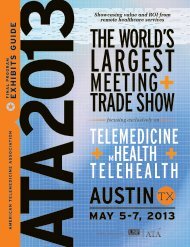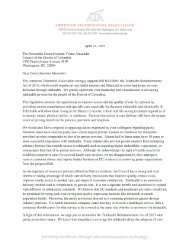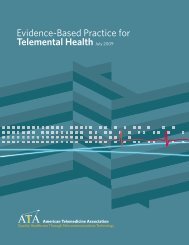Telemedicine
Presentation Abstracts - American Telemedicine Association
Presentation Abstracts - American Telemedicine Association
Create successful ePaper yourself
Turn your PDF publications into a flip-book with our unique Google optimized e-Paper software.
CONCURRENT ORAL PRESENTATIONS ABSTRACTS2. To demonstrate the ability of mobile health technology, automated riskstratification algorithms, and personalized report generation to minimizebarriers to large-scale implementation of injury preventionstrategies.3. To demonstrate the ability of the performance tests to identify functionalmovement deficits in those not fully recovered from a priorinjury.188 IMPLEMENTING SMART PHONE TELE-PHOTOGRAPHY IN TRAUMA:OVERCOMING THE HURDLESPRESENTERS AND CONTRIBUTING AUTHORS:Bellal Joseph, MD, Assistant Professor, Viraj Pandit, MD, Julie Wynne, MD,Arvie Webster, RN, Randall S. Friese, MD, Andrew Tang, MD,Terence O’Keeffe, MB,ChB, Narong Kulvatunyou, MD,Ronald S. Weinstein, MD, Rhee Peter, MD.The University of Arizona, Tucson, AZ, USA.Background: The use of smartphones is advancing and becoming an integralcomponent of patient care in tele-medicine. Now days, smart phones have thecapability to capture and transmit high resolution photographs and videos inreal time. Although recording photographs and videos of patients is notpermitted in most hospitals across the country, this practice is gaining acceptanceand revolutionizing patient care. The use of smart phones inhealthcare is under the peer review of Health Insurance Portability and AccountabilityAct (HIPAA) which allows the utilization of smart phones inhealthcare under certain strict security guidelines and rules. Our institution,over the last two years has safely implemented the use of smart phone telephotographyfor recording photos and videos of all injured trauma patients.The development and implementation of such a system had its intrinsic barrierswhich included:- Assuring hospital administrators and attorneys that smartphone photographycould be safely implemented under HIPAA guidelines.- Compliance of use across all patient care providers (residents, nurses,ancillary staff).- Patient tolerance.Results:- We collected a total of 7,200 photographs of which, 6,120 photographswere good quality.- 3,320 photographs were uploaded into patient electronic records. Thesuccess rate of tele-photography was 54% (3,320/6,120).- The error rate was 0.003% (10/3,320) as 10 photographs were incorrectlyuploaded.- We registered only 3 patient complaints due to HIPAA violations.Conclusion: Tele-photography can be safely and effectively implemented intrauma clinical practice. Fears of HIPAA violations are not valid, as the incidenceof patient complaints is minimal when tele-photography is implementedunder strict guidelines and rules.Objectives:1. The primary objective of this study is to spread awareness about themethods adopted at our institution to overcome practical, administrative,and security hurdles in implementing smart phone tele-photography.2. The secondary objective is to provide an experienced working modelfor other institutions to reference.3. Finally we aim to describe the expansive applications of smart phonetele-photography.185 PHARMACISTS IN TELEMONITORING PRACTICE: A UNIQUE WAYTO PROVIDE CARE TO PATIENTS WITH DIABETESPRESENTERS AND CONTRIBUTING AUTHORS:Laura Shane-McWhorter, PharmD, BCPS, BC-ADM, CDE, FASCP, FAADE,Professor (Clinical) of Pharmacotherapy.University of Utah, Salt Lake City, UT, USAThere are 26 million persons with diabetes, primarily Type 2 diabetes, in theUnited States. Because of lifestyle issues this number is expected to double by2025. Federally-qualified Community Health Centers (CHCs) provide diabetescare to many patients in both urban and rural sites. Traditionally patients seetheir primary care providers every three to six months to evaluate their diabetesstatus. Diabetes treatment involves medication therapy as well as therapeuticlifestyle changes including physical activity and healthy nutrition. Althoughpatients should receive education regarding appropriate healthy lifestyles thereis little time during a typical provider visit. Thus providers must rely on otherclinicians such as nurses, dietitians, and pharmacists to provide diabetes education.Although pharmacists have been traditionally involved in directdistribution of medications and counseling to patients in outpatient and inpatientsettings they are increasingly becoming involved in diabetes care. In anOffice of Assessment Technology grant, a pharmacist has served as the RemoteCare Coordinator for a telemonitoring project for patients with diabetes atCHCs. The pharmacist has a Collaborative Practice Agreement with medicalproviders and may thus directly impact patient care by providing educationand medication management therapy. Patients measure blood glucose, bloodpressure, and weight and transmit the information via a telemonitoring unit toa secure site; the pharmacist then evaluates the information. The pharmacistevaluates clinical outcomes and develops and provides education messages tohelp empower patients to better manage their diabetes. When an out of rangemonitoring parameter (glucose, blood pressure, or weight) is transmitted, thepharmacist works with the patient to determine the cause, provides specificpatient counseling, and delivers feedback to the medical provider. The pharmacistalso communicates with providers regarding the patients’ status andprovides graphical reports that are downloaded to the Electronic Medical Recordevery two weeks. The project has been ongoing for one year and thus farclinical endpoints such as Hemoglobin A1C and blood pressure have improvedfor the majority of patients and patients have increased their knowledge of howto manage their disease state. An important finding is that telemonitoringprovides a way to extend clinical patient care between traditional three or sixmonthmedical appointments. This model provides a unique venue for provisionof pharmacist care to patients.Objectives:1. Describe a unique model to provide diabetes care through telemonitoring.2. Provide specific examples of pharmacist-provided diabetes carethrough telemonitoring.3. Discuss the merits of pharmacist-formulated diabetes education messages.11:00 am–12:00 pm Monday, May 6, 2013PRESENTATION PANELSession Number: 005Session Title: 619 REMOTE NEUROCOGNITIVEASSESSMENT: MILITARY AND CIVILIAN PROJECTSTrack: Best Practices and Service Delivery Models II Meeting Room 17 A/BMODERATOR: Jay Shore, MD, MPH, Associate Professor Department ofPsychiatry.University of Denver, Denver, CO, USA.ª MARY ANN LIEBERT, INC. 2013 TELEMEDICINE and e-HEALTH A-35



